Reception Summer term - Year 1 Autumn Maths assessment: Number
I created these to get an idea of where my year 1 children were with knowing numbers to 20 as well as understanding simple addition and subtraction again using numbers to 20. It gave me clarity on gaps in learning as well as children working above this level. It is not meant as a reading test so I encouraged children to ask an adult to read the instructions for them - similar to a SAT. It also worked when run in a small group as an intervention assessment. I then used the results to target children's weak areas.


